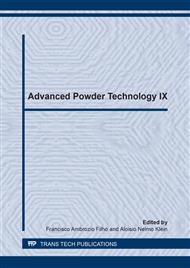p.343
p.349
p.353
p.359
p.367
p.373
p.377
p.383
p.388
Evaluation of Heat Absorption in Iron Ore Using Microwave Energy Source
Abstract:
The phosphorus content has significant effect on the steels quality and their applications. The iron ore resources around the world has continuously increased the amount of phosphorous due to the increase of the mining volume with less sterile generation aiming at the efficient utilization of the mining resources, as consequence larger amount of materials with high iron content but with higher phosphorous has been incorporated in the mining body. An alternative to enhance the mining efficiency is to perform a pre treatment of part of the mining body and subsequent blending to attain the acceptable phosphorous in the steelmaking. A viable alternative for reducing the phosphorus content of these residue is to use the acid leaching process which is considered an economical process for the dephosphorization of the iron ore, however, depending on the way the element phosphorus is contained in the ore it will demand additional energy. The objective of the present paper is to study the effective heating and cooling rates of iron ore using microwave energy and its subsequent cooling effect in a short period (thermal shock). Through the X-ray diffraction analysis and applying the Rietveld method it has been possible to demonstrate the mineralogical composition of the iron ore samples and the effect of rapid heating and cooling suitable to promote the fissure formation, thus enhancing the leaching efficiency. The scanning electron microscopy (SEM) was used to analyze the structure of ore due to the effect of its heating and cooling rates.
Info:
Periodical:
Pages:
367-372
Citation:
Online since:
December 2014
Authors:
Keywords:
Price:
Сopyright:
© 2014 Trans Tech Publications Ltd. All Rights Reserved
Share:
Citation:


